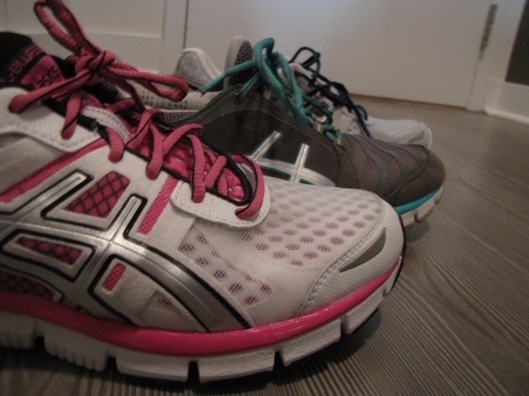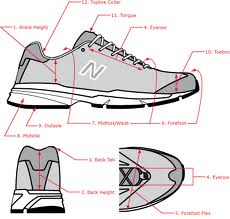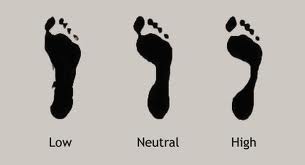Tags
barefoot running, choice, fitness, gait, health, overpronation, running, running shoes, shopping, stride, supination, underpronation
It is extremely easy to get caught up in the millions of details surrounding running shoes. I know, because after 4 months of running somewhat seriously (when it was way past time for me to buy a new pair of shoes) I started to LOSE MY MIND with all the choices that were out there. There were so many things to learn, and I didn’t know where to start. I was paralyzed with fear, doing all sorts of research in attempt to make an informed and regret-proof purchase. Thinking back to my state of panic, I can’t help but shake my head. My first pair of shoes worked fine for me and I barely knew anything then. And christ, it’s just a pair of running shoes right?
But, I had so many questions I wanted answered damnit!
What the hell kind of stride do I have? What is the deal, really, with these minimalist shoes? What does ‘midfoot strike’ mean? Is there really that much of a difference between a $180 pair of shoes and a $120 pair of shoes?
Let me begin by stating that you should really replace your shoes every 300-450 miles (that’s every 483-724 kms for us metric followers). This is not a hard number, and the distance will vary depending on your stride, your weight, and the terrain on which you are running. Generally, if you are heavier/taller, or if you are running on rougher surfaces you should replace your shoes sooner. It’s not a good idea to look at the treads of your shoe for an accurate indication of wear because the midsole (the part with all the cushioning) will usually break down before the bottom of the shoe. Worn out shoes will eventually cause an injury (even if they still look new) – so it’s a good idea to accurately track how much you are running and replace your shoes when it is appropriate.
I know that I put off buying new shoes for too long. I was aware that I had already breached the 500 mile mark but, like a stubborn child, I just kept going. They barely looked used! Luckily I didn’t get injured enough to stop running, but I did start getting terrible back aches in the middle of the night. Then my hips decided, eff this, and began conspiring to detach themselves from my body. Don’t be an idiot like me – if you want to start running, resign yourself to the fact that you will be replacing your shoes often. When compared to other sports, the costs are very minimal. So suck it up buttercup!! (Does writing that make me a cyber bully?)
Obviously, how a running shoe fits is more important than how it looks. Fortunately, I was born with what my dad has always referred to as ‘water skis’ (hyuck!), so fashion in the shoe department has never been a concern of mine. Fact is, most women’s running shoes don’t come in my size and men’s shoes are far too wide – so I take what I can get no matter how awful they look. For fit, a good rule of thumb is to follow the rule of thumb for the toe box. Confused? Don’t be! Simply make sure that you have roughly a thumb’s width of space between your biggest toe (which is not always your first toe) and the front of the shoe. Remember that your feet will swell when you run, and blisters and black toenails aren’t fun. Also, be cognisant of the fact that one foot is almost always bigger than the other (for me it’s my right foot), so make sure that your new shoes fit your biggest foot. Alternatively, you could just go up a half size bigger than what you normally wear – but keep in mind that every shoe will fit differently – even if it is the same brand.
Another thing you are probably going to want to know before buying a new pair of shoes is how you run. People run differently – causing strain on different parts of their bodies. Some have a ‘natural’ pronation, some are overpronated and some are underpronated (also called supinated). Shoes are designed to ‘correct’ these patterns and to prevent injury – so being able to identify your running stride can save you a lot of hassle in the long run (pun intended).
The type of feet that you have also plays a part in the shoes that you should buy, but worry not! The type of feet you have can be determined very easily by the, very appropriately named, ‘wet test’. Simply wet your feet and take normal step onto a dark surface to see the type of imprint each of your feet leaves behind. If your foot print looks like the first image, then you have more of low arched, or flat foot. If your foot print looks something like the middle image, count your lucky stars because you have what our good ol’ society has termed a ‘normal’ foot – meaning you will have a lot more shoes to choose from when you go shopping. If the last image looks more like your feet than you have high arched feet. This means that arch support will be important for you in a shoe.
Apparently, flat footed people are more likely to overpronate, and those people with high arches (or really tight Achilles tendons) are more likely to underpronate. If you aren’t sure how you run or what type of feet you have, go to a shoe store. It’s a good idea to go anyway, especially if it is your first time buying running shoes. They should be more than willing to help you out by checking the wear on your old shoes, watching how you run, suggesting certain types of shoes, and allowing you to run around with the new shoes on in order to get a feel for them. If they aren’t willing to do these things for you then you shouldn’t be giving them your business.
Basically, what it comes down to is knowing what feels good on your own feet. Despite what anyone else tells you, finding the right shoe is more of an art than a science. Only you will know what feels best on your feet (just like how “only you can prevent forest fires”). Reviews from friends or strangers should mean next to nothing, as should brands until you have found something that you know you like. Running in different shoes have helped me learn that I really prefer a lighter shoe, that breathes well and is flexible, and that has more padding on the forefoot than on the heel because I naturally have more of a ‘midfoot’ strike. I also broke my foot quite badly a year ago, so the padding and space in the toe box are important to me. That’s my deal, and you will have your own deal.
Listen to your body, and pay attention to what hurts when, and after, you run. The goal is to run without any pain – and, believe me, it is possible no matter what your experience. If you are having aches and pains in your knees, Achilles tendons, or back – you may be running in the wrong type of shoe, or (in my case) you may be running in a pair of old shoes that simply need to be replaced.
To be fair, some would say that you shouldn’t be running in shoes at all. Proponents of barefoot running claim it is better for your bod (and more natural) to run as you would if you were barefoot. Wearing shoes, they claim, causes you to strike the ground with your heels, causing stress on your joints and muscles. If you run barefoot (or in minimalist shoes), you naturally strike the ground on the ball of your feet, causing less impact force on your body. The debate about the validity of these claims can get quite heated in the running community and, frankly, I’m not convinced either way. I will continue to stand by my earlier claim that only you will know what works best for your body – so don’t be afraid to give barefoot running a try. If you do try it, and you would like to help me enhance my research, please feel share your successes or failures with me – I would love to hear them! Who knows, maybe barefoot running is the answer to all my shoe panic woes!




